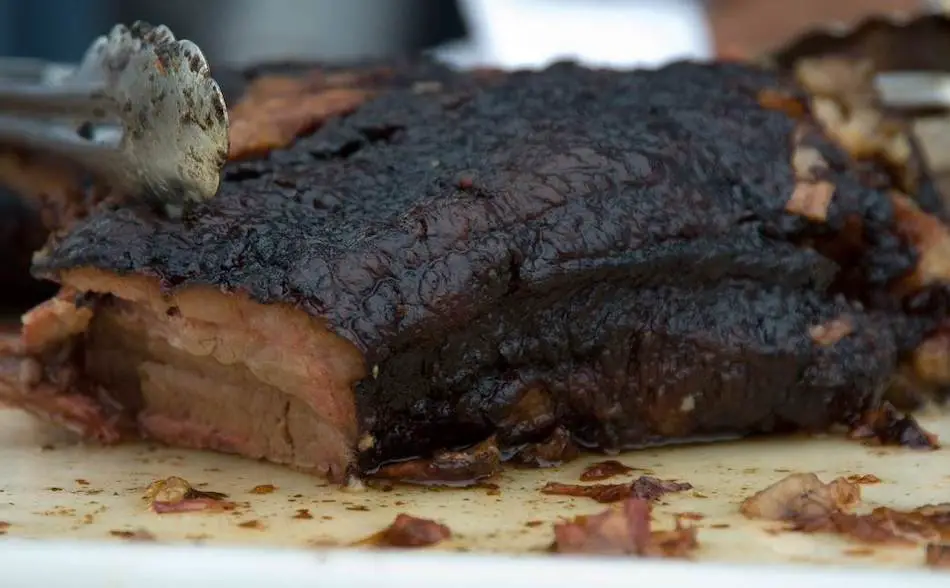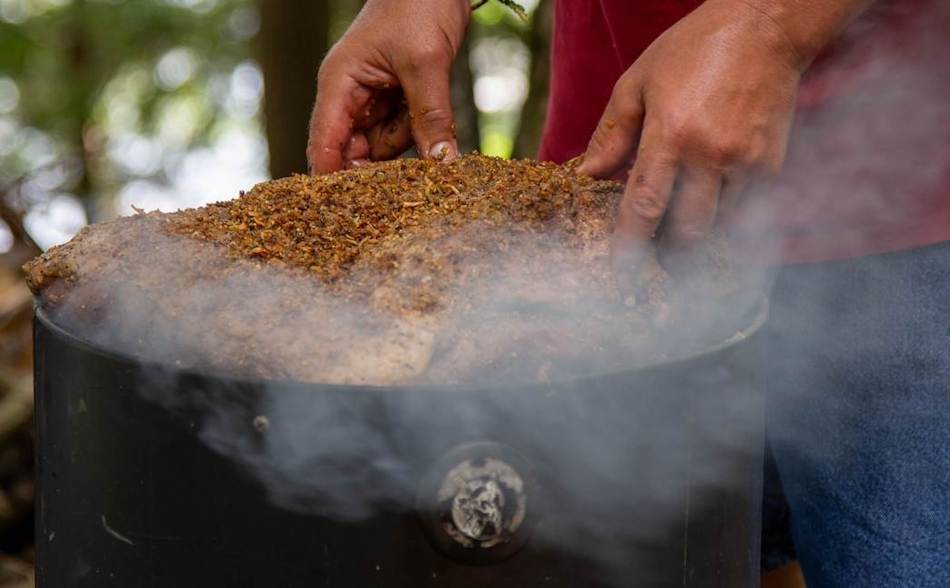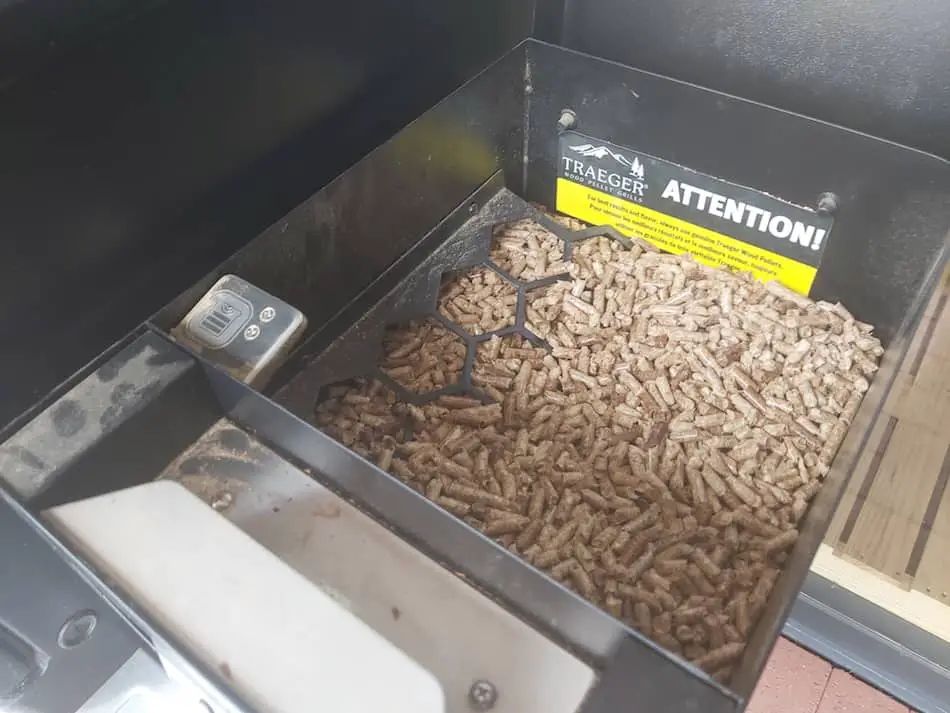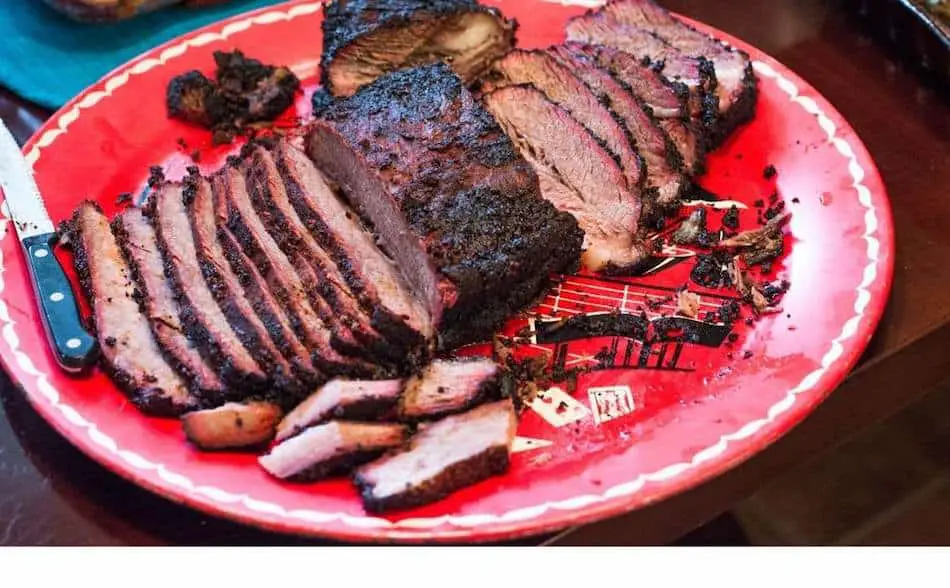
When you first smoke a brisket, it can be alarming to open the lid of your smoker and find a black meteorite sitting on the grill rather than a smoked brisket. I know it looks bad, but the blackness of a smoked brisket isn’t what you think. Most often, the brisket isn’t burned and there is a perfectly good scientific explanation for the color. However, sometimes it can mean your brisket is ruined. I went deep into the science of meat smoking to find out why our briskets turn black. As it turns out, there’s good black brisket and bad black brisket. I’ll walk you through all the reasons so you can get more of the good and less of the bad.
Smoke particles sticking to the meat and reacting with the bark can cause a brisket to turn black during smoking, but this does not always mean the meat is burnt or ruined. In some cases, however, blackness can result from overexposure to bad smoke containing creosote. When you leave a brisket in the smoker for several hours, smoke particles stick to the meat, turning the bark black. This results from a series of chemical reactions on the surface of the brisket. Although it appears to be burned, this is not always the case, and the meat tastes perfectly normal.
Key Points
- Blackness on a smoked brisket can result from a series of chemical reactions on the surface of the meat, or from overexposure to bad smoke containing a substance called creosote
- A black brisket does not necessarily mean the meat is burned or ruined, and can often taste perfectly normal
- The black color on a brisket is a sign that it was smoked low and slow, and is a result of smoke particles sticking to the meat and reacting with the bark (the outer layer of the brisket)
- Different smokers and types of smoke can result in different colored briskets, with charcoal and offset stick burners producing darker meat than electric or gas smokers
- Good smoke enhances the flavor of the meat, while bad smoke can give the meat a bitter taste and ruin the overall flavor
- To protect your brisket from bad smoke, make sure to properly ventilate your smoker and use dry, well-seasoned wood for fuel
- If your brisket has been exposed to too much bad smoke, it will taste bitter and should be discarded
- To determine if a black brisket is good, taste the meat and look for a balanced flavor and moist, tender texture.
Understanding the Science Behind a Black Brisket
If you have followed all of the proper steps in preparing and smoking your brisket, a black color should not be cause for concern. The best way to determine if the meat is good or not is to taste it. Even famous pitmaster Aaron Franklin’s briskets are black, but they are still delicious. However, in some cases, a black brisket can result from overexposure to bad smoke. If this is the case, the meat will have a bitter, ashtray-like flavor and should be discarded.
| Reason for Black Brisket | Description |
|---|---|
| Chemical reactions during smoking | Smoke particles stick to the meat and react with the bark, resulting in a black color |
| Overexposure to bad smoke | Blackness can result from exposure to bad smoke, specifically a substance called creosote, which can give the meat a bitter taste |
| Different smokers and types of smoke | The type of smoker and smoke used can affect the color of the brisket, with charcoal and offset stick burners producing darker meat than electric or gas smokers |
| Good smoke | Enhances the flavor of the meat |
| Bad smoke | Can give the meat a bitter taste and ruin the overall flavor |
Why Does Smoked Meat Look Burnt?
The black color on a brisket is a sign that it was cooked using a low and slow smoking method, which is generally considered the best way to smoke a brisket. This method of cooking allows the smoke to fully penetrate the meat and infuse it with flavor.
The black color itself is not a result of the meat being burnt, but rather a result of chemical reactions that occur between the smoke particles and the bark, or outer layer, of the brisket. The bark is made up of a combination of rub, fat, and smoke, and is usually crispy and flavorful. If you were to apply a rub to a brisket and roast it in the oven, it would likely turn a mahogany red color.
However, when the same brisket is placed in a smoker, the smoke particles will stick to the outer layer of the meat and cause it to turn black. This blackening process typically occurs after the brisket has been in the smoker for 5 to 10 hours. While the black color of the brisket may not look appetizing, it does not mean the meat is burnt or ruined. The brisket is simply covered in a flavorful, black bark.
The Different Stages of Brisket Color During Smoking
A brisket will change colors as it cooks. At the beginning of the cooking process, the meat will typically have a reddish color. As the cooking progresses, the color will change to a dark black. It is important to note that the black color on a properly cooked brisket is not the same as the black color on a burnt brisket.
The black color on a burnt brisket is caused by carbon, while the black color on a properly cooked brisket is caused by chemical reactions between the smoke particles and the bark of the meat.
A traditional Texas-style brisket, which is known for its strong smoke flavor, will often look like a black meteorite after several hours of smoking. While the black color of the meat may not look appealing, it does not mean that the meat is burnt or ruined. In fact, a properly cooked Texas brisket will taste far better than it looks. Just watch a video of famous pitmaster Aaron Franklin to see what a properly cooked, black brisket looks like.
1. How Smoker Type Affects the Color of Smoked Meat
The color of a smoked brisket can also be affected by the type of smoker that is used. Different smokers produce different types of smoke, which can impact the color of the meat. For example, a charcoal smoker will typically produce a darker, smokier flavored brisket than an electric smoker. Similarly, a brisket that is cooked on an offset stick burner, which is a type of smoker that uses wood or charcoal as fuel, will be darker in color than a brisket that is cooked in a gas smoker for the same amount of time.
The type of smoke produced by the smoker can also affect the flavor of the meat, with different types of wood and charcoal producing distinct smoke flavors. It is important to consider the type of smoke that you want for your brisket when choosing a smoker.
2. Distinguishing Good Smoke from Bad Smoke for Perfectly Flavored Brisket
Smoke is an important factor in the color and flavor of a smoked brisket. As we have already discussed, the smoke particles that stick to the surface of the meat during the smoking process can cause the bark of the brisket to turn black. This black color is often a desirable result, as it indicates that the meat was cooked low and slow and has absorbed the flavorful smoke.
However, it is important to make sure that the brisket is getting good smoke and not bad smoke. Good smoke, which is produced by well-seasoned wood and properly ventilated smokers, will enhance the flavor of the meat and give it a delicious smoked taste. On the other hand, bad smoke, which is often produced by wet or unseasoned wood, can give the meat a bitter or unpleasant taste and ruin the overall flavor. If a black brisket has been exposed to bad smoke, it will not only look unappealing, but it will also taste disgusting. It is important to pay attention to the type of smoke that your brisket is exposed to in order to ensure a delicious final product.
3. Protecting Your Brisket from Over-Exposure to Bad Smoke
Smoke contains a variety of different compounds that can affect the flavor and appearance of a smoked brisket. One of these compounds is creosote, which is a tar-like substance that is produced when wood is burned. Creosote is found in all smoke, whether it is produced by wood, lump charcoal, or briquettes, and it gives the meat a delicious smoked flavor and dark color. Without creosote, the meat would not have any smoke flavor and would not turn black.
However, it is important to be mindful of the amount of creosote that is present in the smoke, as too much creosote can give the meat a bitter taste. Creosote is produced when the temperature of the fire is too low or when the fire is not properly ventilated, so it is important to maintain a consistent temperature and proper ventilation in your smoker in order to prevent an excess of creosote. Too much creosote can ruin the flavor of your brisket, so it is important to be aware of the amount of creosote present in the smoke in order to ensure a delicious final product.
| Action to Take | Description |
|---|---|
| Properly ventilate smoker | To protect the brisket from bad smoke |
| Use dry, well-seasoned wood | To produce good smoke |
| Discard brisket exposed to too much bad smoke | The meat will taste bitter |
| Taste the meat | To determine if the black brisket is good or bad, look for a balanced flavor and moist, tender texture |
4. What to Do if Your Brisket Gets Too Much Bad Smoke
If you want to avoid bad smoke ruining your brisket, it’s important to keep your smoker clean. A dirty smoker can produce dirty smoke, which is filled with layers of creosote on the grill and metal of the cooking chamber. This black, greasy substance can create black smoke that can give your brisket a bitter taste if it is exposed to it for long periods of time.
To reduce the risk of bad flavors ruining your brisket, it is essential to wash your cooking grates regularly and remove any goo or buildup on the walls of your smoker. This will help to ensure that the smoke is clean and free of contaminants that can affect the flavor of the meat.
Also, pay attention to the fuel that you are using in your smoker, as using wet or unseasoned wood can produce dirty smoke that can ruin the flavor of your brisket. By maintaining a clean smoker and using dry, well-seasoned wood, you can help to ensure that your brisket turns out delicious and free of any unpleasant flavors.

5. Good Airflow Equals Good Smoke
Another way soot can cover your brisket is from poor airflow in your smoker. It’s always a good idea to open your top vents/dampers so that smoke can escape. Keep the bottom vent open a crack so that air can flow through your fire, giving it plenty of oxygen. If you follow these steps, you can help ensure that your brisket is getting good smoke. On the other hand, if your smoker is dirty, has poor airflow, or if the fire is not burning properly, the smoke produced will be “bad smoke” and can ruin your brisket by giving it a bitter taste and coating it in soot. It is important to pay attention to the quality of the smoke being produced and make adjustments as needed to ensure that your brisket is getting the good smoke it needs to turn out delicious.
6. Wood Influences The Color Of Your Brisket
Wood can have a significant influence on the flavor and color of the brisket when smoking. Different types of wood will impart different flavors to the meat, and can also affect the color. For example, oak wood is a popular choice for smoking brisket because it imparts a strong, smoky flavor and can give the meat a nice reddish-brown color. In addition to oak, cherry wood is another popular choice for smoking brisket because it imparts a mild, fruity flavor and can give the meat a dark, reddish-brown color.

7. Avoid Smoke From Grease
Using a drip tray or a water pan when smoking a brisket can help to avoid bad smoke and ensure that the meat turns out delicious. When the fat and drippings from the brisket fall onto the fire, they can produce a bad smoke that can affect the taste of the meat. While a few hours of exposure to this type of smoke may not harm the meat, prolonged exposure (such as 5 to 8 hours) can significantly impact the flavor. By using a drip tray or water pan to catch the fat and drippings, you can prevent them from reaching the fire and causing this problem. This will help to ensure that your brisket turns out flavorful and delicious.
8. Reduce Creosote and Soot On Your Brisket
When we smoke brisket, we have to keep the temperature low so the connective tissue has time to break down. However, when smoking meat at low temperatures, food scientist Dr. Blonder says cooking at 225°F moves some smokers, “below the ideal combustion zone which creates black smoke, soot and more creosote.” This isn’t the case with all smokers but is true is ceramic charcoal grills such as The Big Green Egg and Kamado Joe. As mentioned before, creosote produces the flavor and color on our brisket, however too much creosote is a bad thing and we want to keep it to a minimum.
9. The Browning Effect
The Maillard reaction is the browning effect on cooked meat. This reaction doesn’t occur when you steam or boil but, but it only takes place when the meat is cooked using a dry heat. In simple terms, a bunch of chemical reactions take place on the surface of the meat and the meat will turn brown and become crunchy, and with brisket, it helps form the much loved bark on the outer layer of the meat.

10. Caramelization
Sugar also contributes to the darkening of brisket. When sugar burns (usually once the temperature reaches the standard smoking temperature of 225°f), the sugar will turn black. Many rubs, sauces, mops and spritzes may contain sugar, which may contribute to the meat turning black. When making my homemade brisket rub, I always be careful not to put sugar or salt into my rub mixture. I prefer to salt my brisket separately to avoid over salting my brisket. I leave sugar out of my brisket rub, however I include brown sugar in my or and chicken rub. Some smoking meats will apply a glaze at the end of the cook, such as barbeque sauce. As you would know, barbeque sauce has a high sugar content. If the barbeque sauce burns, it will turn the meat black. However, brisket recipes rarely include a glaze, so this is more relevant to ribs or pork belly.
My Favorite Brisket Tools
Thanks for checking out this article. I hope you learned a few things. Here are some of my favorite tools I use when smoking brisket that may be useful to you. These are affiliate links, so if you decide to purchase any of these products, I’ll earn a commission. But in all honesty, these are the tools I recommend to my family and friends who are just starting out.
Meat Injector: Injecting meat is a great way to take your barbecue to the next level and help you make competition-style brisket. An injector is the only way you will be able to get flavor and moisture into the middle of the meat. The Beast Injector is a stainless steel injector that is sturdy and affordable. Check the latest price on Amazon here.
Brisket Marinade: The best injection solution on the market is the Butcher BBQ Brisket Injection. This marinade is used in competitions and is made by World Barbecue Champion pitmaster, Dave Bouska. You can find the marinade on Amazon here.
Butcher Paper: Wrapping brisket in butcher paper has become a huge trend in barbeque thanks to Aaron Franklin. Wrapping your brisket in paper will give you a nice brisket bark. However, you can’t just use any old paper, it has to be unwaxed, food grade paper. You can find it on Amazon here.
Brisket Rub: These days I make my own rub when possible, but I always have a few pre-made rubs for when I’m running low. Barbecue guru Malcom Reed produces Killer Hogs, one of the best brisket rubs I’ve found over the years. Another great rub is Slap Yo Daddy, made by brisket master and multiple World Barbecue Champion, Harry Soo.
Meat Thermometer: There are dozens of fancy thermometers on the market, but I still use my trusty TP20. For around $50, I have a high-quality meat thermometer with two probes, and can track the temperature of my smoker with one probe, and my meat with the other probe. The ThermoPro TP20 is an Amazon Best Seller because it’s the easiest thermometer to operate, is durable, highly accurate, and comes with pre-programmed meat settings.
Instant Read Thermometer: Arguably, the second most important tool you need is a fast and accurate instant-read thermometer. These tools play an important role in the latter stages of the cook when the meat needs regular checking in multiple areas. I use the ThermoPro TP19 because it can do everything a ThermaPen can do, but for a fraction of the cost. You can check out the TP19 on Amazon here.
Advanced Thermometer and Automatic Temperature Controller: Once you’re ready to take things seriously, the FireBoard 2 Drive is a six-channel Bluetooth/Wi-Fi thermometer that can monitor up to 6 pieces of meat, control and graph your cook sessions on your smartphone, and attaches to an an automatic blower that will convert your charcoal smoker to a set-and-forget. This is one of the most advanced meat thermometers on the market. You can check it out on the FireBoard website here.
